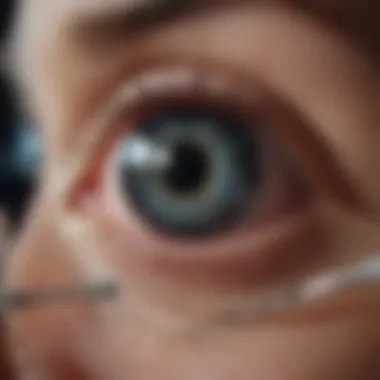Loteprednol: A Breakthrough in Dry Eye Treatment


Intro
Dry eye syndrome presents a significant challenge for many individuals, impacting their quality of life. In the quest for relief, various treatment options are available. Among these, loteprednol stands out as a corticosteroid that can help alleviate symptoms associated with dry eyes. This article will explore the role of loteprednol in treating this condition, examining its mechanism of action, efficacy in clinical settings, possible side effects, and practical guidelines for practitioners.
Key Concepts
Definition of the Main Idea
Loteprednol is a synthetic corticosteroid formulated to provide potent anti-inflammatory effects while causing less irritation to the ocular surface. Its primary use revolves around reducing inflammation that often contributes to the symptoms of dry eye syndrome. By understanding how it functions at a cellular level, healthcare professionals can make informed decisions about its application in treatment regimens.
Overview of Scientific Principles
The mechanism of action of loteprednol primarily involves the inhibition of pro-inflammatory cytokines. This action decreases inflammation, which is a common contributor to dry eye symptoms. Loteprednol achieves this by modulating the immune response and thus reducing tear film instability. Additionally, its unique formulation allows for lower penetration into deeper ocular tissues, reducing the likelihood of systemic side effects compared to traditional corticosteroids.
"The goal of loteprednol therapy is to provide relief from symptoms while minimizing potential harm to the ocular surface."
"The goal of loteprednol therapy is to provide relief from symptoms while minimizing potential harm to the ocular surface."
Current Research Trends
Recent Studies and Findings
Recent clinical studies have highlighted loteprednol's effectiveness in managing dry eye syndrome. One notable study demonstrated significant improvement in tear break-up time and ocular surface staining scores among patients using loteprednol compared to those on other treatments. This growing body of evidence supports the consideration of loteprednol as a first-line therapy in specific patient populations.
Significant Breakthroughs in the Field
With increasing interest in the role of inflammation in dry eye disease, loteprednol's profile continues to be researched extensively. Breakthroughs in understanding its pharmacokinetics and long-term safety are vital. New formulations and delivery systems are also under investigation to enhance its therapeutic efficacy. Researchers are actively exploring combinations with other treatment modalities to maximize patient outcomes.
In summary, loteprednol presents an encouraging option for individuals suffering from dry eye syndrome. Continued research and clinical application of this corticosteroid could lead to improved management strategies, benefiting both patients and healthcare professionals.
Foreword to Dry Eye Syndrome
Dry eye syndrome is a condition that has gained significant attention in recent years, especially as the prevalence of digital device usage increases. Understanding this syndrome is crucial for anyone involved in eye care or those experiencing eye discomfort. This article will explore the implications of dry eye syndrome and how it relates to treatment options such as loteprednol.
Definition and Overview
Dry eye syndrome is characterized by a decrease in tear production or an increase in tear evaporation. This leads to inflammation and damage to the eye's surface. It is more than just a minor irritation; it can severely impact a person's daily life, influencing their ability to read, drive, and engage in many activities. The condition affects various age groups but is particularly common among older adults and individuals with long-term exposure to screens.
Prevalence and Impact
The prevalence of dry eye syndrome is noteworthy. Studies indicate that approximately 5 to 30 percent of the population experiences symptoms of dry eye. Factors contributing to this issue include environmental influences, extended screen time, and certain medical conditions. The impact ranges from mild discomfort to significant impairment. Many people report a decreased quality of life because of the symptoms associated with dry eyes. Therefore, awareness and understanding of the condition are vital, both for patients and healthcare providers.
Common Symptoms
Symptoms of dry eye syndrome can vary significantly among individuals. The most common symptoms include:
- A sensation of dryness, often described as gritty or sandy
- Redness and inflammation of the eye surface
- Burning or stinging sensations
- Increased sensitivity to light
- Blurry vision
These symptoms can vary in intensity and can be triggered or worsened by factors like air conditioning, wind, or prolonged periods of focusing on screens. Patients may not only endure physical discomfort but also experience emotional distress due to limitations in daily activities.
"Understanding dry eye syndrome is essential for effective management and treatment, enhancing the overall quality of life for those affected."
"Understanding dry eye syndrome is essential for effective management and treatment, enhancing the overall quality of life for those affected."
The comprehensiveness of addressing dry eye syndrome sets the stage for exploring treatment options like loteprednol, which will be examined in subsequent sections.


Understanding Loteprednol
Loteprednol represents a significant option in the management of dry eye syndrome. Its formulation is designed to alleviate inflammation and improve tear film stability. Knowledge of this corticosteroid's attributes provides a vital foundation for its application in therapeutic settings. Healthcare professionals must understand the detailed characteristics of loteprednol to make informed treatment decisions. Furthermore, knowledge of its benefits and potential limitations is essential to optimize patient outcomes.
Chemical Composition
Loteprednol etabonate is the active ingredient in loteprednol formulations. It belongs to the class of corticosteroids. The compound’s structure is characterized by a notable ester group, which distinguishes it from other corticosteroids. This unique composition allows for a strong anti-inflammatory property while reducing the likelihood of prolonged ocular pressure increase.
The formulation usually includes preservatives, resulting in various forms like eye drops or ointments. Preservative-free options have also come into the market, catering to patients with persistent dry eyes or sensitivities. Understanding its chemical composition helps in recognizing the role it plays in reducing symptoms of inflammation and pain associated with dry eye syndrome.
Mechanism of Action
The mechanism through which loteprednol exerts its therapeutic effect is multifaceted. The drug binds to glucocorticoid receptors within ocular tissues. This binding modulates various inflammatory pathways, effectively reducing the production of pro-inflammatory cytokines. By inhibiting these responses, loteprednol promptly alleviates discomfort and irritation associated with dry eye syndrome.
Additionally, loteprednol enhances tear production. This increase helps to maintain ocular surface lubrication, addressing one of the primary concerns in dry eye patients. Due to its rapid action, loteprednol is often preferred in situations requiring quicker symptomatic relief. Its anti-inflammatory effect reduces redness and swelling in the eyes within a short duration of application.
Pharmacokinetics
Pharmacokinetics of loteprednol involves absorption, distribution, metabolism, and excretion. After instillation, the drug is rapidly absorbed into the ocular tissues. The peak concentration in the cornea occurs relatively quickly, often within a few hours. Loteprednol has a short half-life, allowing it to be metabolized rapidly. This is an advantage, as it minimizes the potential for systemic side effects that are common with longer-acting corticosteroids.
The metabolism primarily takes place in the liver, where it is converted into inactive metabolites. These metabolites do not show significant ocular effects, ensuring that prolonged exposure to active corticosteroid does not occur. This factor is critical in managing the safety profile of loteprednol, as noted in its clinical use.
In summary, understanding the pharmacokinetics of loteprednol helps in guiding the recommended dosage and frequency of administration, potentially leading to optimal therapeutic outcomes.
Clinical Applications of Loteprednol
The clinical applications of loteprednol in the management of dry eye syndrome are substantial. This medication is a unique corticosteroid that plays an important role in reducing ocular inflammation, which can lead to better patient outcomes. Understanding how loteprednol works in clinical settings is essential for both healthcare providers and patients.
Efficacy in Treating Dry Eye Syndrome
Loteprednol has shown pronounced efficacy in the treatment of dry eye syndrome. Clinical studies suggest that it significantly alleviates symptoms and improves tear production. The anti-inflammatory properties of loteprednol are particularly noteworthy, as they contribute to reducing ocular discomfort. Patients often report a decrease in redness and irritation following treatment. Overall, loteprednol can be a vital component in the management of this condition, especially for individuals who do not respond adequately to standard therapies.
Dosage and Administration Guidelines
Proper dosage and administration are crucial to maximize the benefits of loteprednol while minimizing potential side effects. The standard recommendation is typically one to two drops in the affected eye four times daily. However, adjustments may be necessary based on the severity of symptoms and patient response. Adherence to this regimen is necessary to achieve optimal results, and patients should always consult their healthcare providers before altering dosage.
Comparison with Other Treatments
The comparison of loteprednol with other treatment options for dry eye syndrome helps highlight its unique benefits.
Artificial Tears
Artificial tears are widely used for symptom relief in dry eye syndrome. They provide immediate hydration and comfort. A key characteristic of artificial tears is their accessibility and ease of use. Their major advantage is that they can be used frequently without significant side effects. However, they may not address underlying inflammation effectively, which is where loteprednol can play a complementary role.
Other Corticosteroids
Other corticosteroids, such as prednisolone and dexamethasone, are also utilized in managing ocular inflammation. A distinguishing characteristic of these medications is their potency and potential for more serious side effects. While effective for short-term use, they may not be ideal for long-term management due to their risk of increased intraocular pressure. Loteprednol differentiates itself by having a safer profile for extended use in managing dry eye syndrome.
Nonsteroidal Anti-Inflammatory Drugs
Nonsteroidal anti-inflammatory drugs (NSAIDs) like ketorolac are an alternative treatment path. Key features of NSAIDs include their effectiveness in pain relief and inflammation reduction. They are valuable, especially in certain populations. However, their onset of action is delayed compared to loteprednol. Moreover, the consistency of their use can vary, impacting patient compliance. Loteprednol presents a stronger option for immediate relief, particularly with ongoing treatment requirements in dry eye management.
The comparison of loteprednol with other treatments illustrates its unique position in the therapeutic landscape of dry eye syndrome.
The comparison of loteprednol with other treatments illustrates its unique position in the therapeutic landscape of dry eye syndrome.


In summary, understanding the clinical applications of loteprednol is critical for managing dry eye syndrome effectively. Recognizing its efficacy, following proper dosage guidelines, and contextualizing its use in relation to other treatments enables healthcare providers to develop personalized treatment strategies for their patients.
Safety Profile of Loteprednol
The safety profile of loteprednol is crucial in the context of it being a treatment for dry eye syndrome. Understanding both the common side effects and potential serious adverse reactions is essential for both healthcare providers and patients. This section also discusses contraindications that may affect the choice to use this medication. These considerations will help inform treatment decisions, enhance patient safety, and ensure that healthcare professionals can manage treatment effectively.
Common Side Effects
Patients undergoing treatment with loteprednol may experience a range of common side effects. These side effects are often mild but can impact treatment adherence if not adequately managed. Some frequent side effects include:
- Burning or stinging: This often occurs upon application and is typically transient.
- Dryness or irritation: Some patients report increased dryness, which seems counterintuitive but is not uncommon.
- Blurred vision: Temporary visual disturbances can arise.
These side effects are generally not severe, therefore monitoring is often sufficient. However, patients should be advised to report any persistent issues that disrupt their daily life, as it may necessitate a reevaluation of the treatment plan.
Serious Adverse Reactions
Serious adverse reactions, while less common, can occur with the use of loteprednol. It is important for both healthcare providers and patients to be aware of these potential outcomes, as early identification can lead to timely intervention. Serious reactions may include:
- Increased intraocular pressure: This can potentially lead to glaucoma if not monitored.
- Infections: Steroid use can increase susceptibility to eye infections.
- Corneal issues: Rare cases of ulceration or perforation have been documented.
Patients experiencing sudden vision changes or eye pain should seek immediate medical attention. Regular follow-ups can help minimize risks associated with these serious reactions.
Contraindications
Certain conditions and circumstances may contraindicate the use of loteprednol. Recognizing these factors is essential for safely prescribing this medication. Contraindications include:
- Active infections: If the patient has an existing eye infection, the use of corticosteroids could exacerbate the situation.
- Hypersensitivity: Any known allergies to loteprednol or similar corticosteroids should preclude its use.
- Certain ocular diseases: Patients with a history of herpes simplex keratitis or other specific ocular diseases may be at greater risk of complications.
In these cases, alternative treatments or precautions should be contemplated to ensure patient safety.
It is essential for healthcare providers to conduct a thorough assessment before initiating treatment with loteprednol, balancing the benefits against potential risks.
It is essential for healthcare providers to conduct a thorough assessment before initiating treatment with loteprednol, balancing the benefits against potential risks.
Comparative Analysis with Other Treatments
In the landscape of dry eye syndrome therapies, understanding how loteprednol compares with other treatment options is essential for effective patient care. This analysis highlights not only the efficacy of various treatments but also their impact on patient satisfaction and overall cost-effectiveness. This understanding allows healthcare professionals to make informed decisions in prescribing the most appropriate therapies for their patients.
Efficacy Metrics
Efficacy metrics serve as a benchmark when evaluating the success of different treatments for dry eye syndrome. For loteprednol, clinical trials have demonstrated significant improvements in symptom relief compared to placebo. For instance, studies showed that patients reported a notable reduction in dryness, burning, and other associated symptoms after using loteprednol. Comparatively, artificial tears often offer temporary relief but may not address underlying inflammation.
- Loteprednol: Rapid onset of action; sustained effect over time.
- Artificial Tears: Short-term relief; suitable for mild cases.
- Other Corticosteroids: Effective but may pose higher risk of side effects, including increased intraocular pressure.
The efficacy of any treatment is a critical factor in patient adherence, making it paramount to weigh these metrics carefully.
Patient Satisfaction Rates
Patient satisfaction is a crucial aspect to consider in any treatment plan. Studies indicate that users of loteprednol report higher satisfaction rates compared to those using other therapies. Factors influencing patient satisfaction include:
- Length of relief: Loteprednol provides prolonged symptom relief, leading to increased patient comfort.
- Side effects: Patients appreciate fewer side effects, which is often a concern with long-term steroid use.
- Administration frequency: Loteprednol is typically administered fewer times per day than many artificial tears, simplifying treatment regimens for patients.
This higher satisfaction has beneficial implications for adherence to treatment recommendations, emphasizing the importance of patient perspectives in therapy choice.
Cost-Effectiveness


Cost-effectiveness is a multifaceted consideration when evaluating dryness treatments. While loteprednol may have a higher upfront cost compared to basic artificial tears, the long-term benefits can provide better overall value. Factors contributing to cost-effectiveness include:
- Reduced frequency of use: Loteprednol’s efficacy allows for less frequent dosing, which may reduce overall costs.
- Fewer side effects: With minimal complications, patients are less likely to require additional treatments.
- Quality of life improvements: Enhanced comfort and satisfaction lead to fewer visits to healthcare providers, reducing indirect costs associated with chronic dry eye management.
Best Practices for Healthcare Professionals
Understanding the best practices for healthcare professionals when using loteprednol in the treatment of dry eye syndrome is crucial. Proper practices not only improve patient outcomes but also ensure the safe use of this therapy. Adhering to established guidelines can help mitigate risks associated with side effects and improve overall treatment efficacy.
Patient Assessment and Diagnosis
Before initiating treatment with loteprednol, thorough patient assessment is essential.
- Comprehensive History: It is important to gather a complete medical history, including pre-existing conditions and current medications that may interact with corticosteroids.
- Symptom Evaluation: Assessing the severity and duration of dry eye symptoms helps to determine the appropriate use of loteprednol. Utilizing standardized questionnaires can provide quantifiable data regarding symptom impact on daily living.
- Objective Testing: Performance of diagnostic tests, like tear break-up time or osmolarity assessments, aids in objectively identifying the extent of dry eye syndrome. This ensures a targeted approach to treatment.
Tailoring Treatment Plans
When creating treatment plans, healthcare professionals must consider individual patient needs and preferences.
- Dosage Considerations: Different patients may require varying dosages of loteprednol depending on their specific symptoms and responsiveness to treatment.
- Combination Therapies: Using loteprednol alongside artificial tears or other therapies can enhance treatment effects, especially in patients with moderate to severe symptoms.
- Patient Education: Educating patients about the purpose of loteprednol and its benefits helps in fostering adherence to the treatment regime. Highlighting possible side effects allows patients to make informed decisions.
Monitoring and Follow-Up
Monitoring patients during treatment with loteprednol is paramount to ensure safety and effectiveness.
- Initial Follow-Up: Scheduling follow-up appointments within the first month of therapy allows healthcare professionals to assess the response to treatment. Adjustments to the therapy should be made based on clinical evaluations.
- Long-Term Monitoring: Regular assessments every few months may be necessary to observe for any emerging side effects or diminishing efficacy.
- Patient Feedback: Encourage patients to report changes in symptoms or new side effects at any time, promoting a proactive approach to managing their therapy.
Future Directions in Dry Eye Treatment
The landscape of dry eye treatment is evolving. This section examines the importance of adopting forward-thinking strategies in managing dry eye syndrome. As understanding of the condition expands, new therapies and research initiatives emerge, paving the way for improved patient outcomes. The relevance of these developments cannot be overstated, as they not only enhance the effectiveness of existing treatments like loteprednol but also promise to address the nuances of dry eye syndrome that many patients currently experience.
Understanding the future directions in dry eye treatment ensures that healthcare professionals stay informed about the latest options. Given the complexity of dry eye, which includes multiple underlying causes such as inflammation and decreased tear production, innovative therapies can offer tailored solutions to patients. By being aware of emerging therapies and ongoing research initiatives, practitioners can guide patients effectively, leading to better management of this condition.
Emerging Therapies
Emerging therapies represent a significant advancement in treating dry eye. These therapies are developed to target the underlying mechanisms of the condition rather than just alleviating symptoms. Some of the noteworthy emerging treatments include:
- Lifitegrast: This drug functions as a lymphocyte function-associated antigen-1 (LFA-1) antagonist. It aims to reduce inflammation in the eye and manage dry eye symptoms more effectively.
- Ciclosporin A: Initially used as an immunosuppressant, this medication is now being explored for its role in increasing tear production by reducing inflammation.
- Sustain: As a new formulation of artificial tears, it boasts enhanced viscosity for longer retention in the eye, providing more sustained relief from dryness.
These emerging therapies focus not only on symptom relief but also on restoring the ocular surface health. As these options become available, clinical trials will be vital in demonstrating their safety and efficacy.
Ongoing Research Initiatives
Ongoing research plays a crucial role in the future of dry eye treatment. Significant initiatives are underway to study novel approaches and further understand the mechanisms of the condition. Some key areas of focus include:
- Regenerative Medicine: Research into the use of autologous serum tears is underway, where the patient’s own blood is used to create eye drops that better mimic natural tears.
- Gene Therapy: This innovative approach aims to introduce genes that enhance tear production or reduce inflammation directly into the ocular tissues, offering a long-term solution.
- Nanotechnology: This field investigates the delivery of active compounds to the eye at a cellular level, potentially leading to more effective therapies with fewer side effects.
The outcomes from these research initiatives will be pivotal in shaping new treatment protocols. With advancements in technology and a deeper understanding of dry eye syndrome, the future holds promise for effective management strategies that were not previously possible.
The End
The conclusion serves as a vital wrap-up for the extensive discussions presented in this article regarding loteprednol and its application in managing dry eye syndrome. This segment underscores the relevance of understanding loteprednol not just as a therapeutic option, but as a comprehensive approach addressing the complexity of dry eye conditions.
Summary of Key Points
Loteprednol, a corticosteroid formulation, plays a crucial role in the treatment landscape for dry eye syndrome. Its unique mechanism of action helps to reduce inflammation and increase comfort for patients experiencing this condition. Key takeaways include:
- Efficacy: Loteprednol shows promising results in improving patient symptoms and overall eye health when used appropriately.
- Safety: Compared to other corticosteroids, loteprednol has a favorable safety profile which is particularly important in prolonged use scenarios.
- Comparative Advantages: Its use in conjunction with artificial tears and other treatments can enhance patient outcomes.
- Best Practices: Healthcare professionals should assess individual patient needs to tailor treatment plans effectively.
Final Thoughts on Loteprednol in Dry Eye Management
Ultimately, ongoing research into new therapies will complement and enhance the effectiveness of existing treatments like loteprednol. As practitioners and patients continue navigating the complexities of dry eye management, a solid understanding of loteprednol's role will be essential in optimizing treatment strategies and improving quality of life for many.







